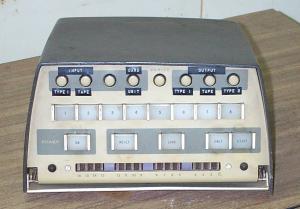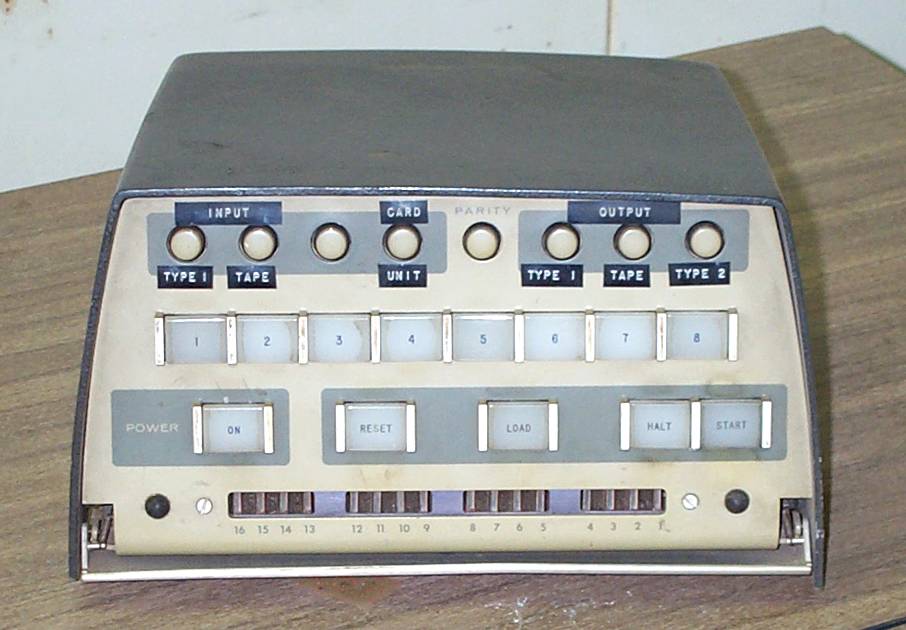Monrobot XI Technology
Logic and CPU
The Monrobot XI was constructed with discrete component logic, using transistors in all circuits except for the high-power output drivers for the electric typewriters, where vacuum tube thyratrons were used.
The architecture used a 32-bit word with 16-bit opcodes packed two per word. The data paths were bit-serial, this suited the memory architecture and permitted maximum economy of circuitry as all internal data paths and arithmetic/logic elements only needed to be one bit wide.
Main Memory
The memory system was entirely based on a magnetic drum that rotated at approx 5k rpm. Main store was 1024 32-bit words and this could be increased to 2048 words on the same drum. There was one read/write head per track, data was written and read bit-serially, naturally leading to a bit serial architecture for the entire machine. If the required instruction or data was not immediately available at the read/write head then the machine would have to wait for the drum to rotate until the data became available. This could be a significant period compared to the execution time of the electronics and programmers would therefore often have to consider the arrangement of data on the drum, so as to avoid drum rotation waits.
The machine’s accumulator and working registers were not held in electronic storage, but were also stored on the memory drum. In order to reduce drum waits for these commonly used registers, they were designated as “Fast Access” (FA) Registers and four (six?) read/write heads were spaced around the circumference of the drum, enabling very low latency for these six special registers. FA6 was the machine accumulator, some of the other FA’s were used for multiplication and division, while others were available for general use where fast access was desirable.
Display and Keyboard
Input/Output was by modified IBM electric typewriters. Pressing keys generated inputs to the computer while output commands activated solenoids under the keyboard that actually pressed the keys, as if an invisible typist was working the keyboard.
A small console provided controls for starting, stopping and single-stepping the machine. Indicator lights showed transfer requests to and from peripherals and there were eight buttons that could be set by the operator and tested by the program. A small flap at the bottom revealed a set of neon lamps that showed the contents of the accumulator register.
Mass Storage
Standard mass storage was punched paper tape. Software was saved and loaded from paper tape with commonly used routines generally hanging on wall hooks beside the machine. Two tape reader/punches were provided allowing data files to be processed by entering reading an input tape on each reader, processing the updates on one tape against the master data on the other and then punching a marged and updated result.
The Monro-Card system was another form of mass storage using magnetic cards that could be read and updated in a card reader. The reader had two output hoppers that could be selected under software control so that cards could be sorted according to the data they contained.
Operation
Starting the Monrobot XI took some time as the magnetic drum had to be brought up to operating speed. This was accompanied by a steadily increasing high-pitched whine, similar to a jet engine starting. When a familiar pitch of sound was reached then the speed was correct and soon after the control panel lit up, ready for input. Since the magnetic drum preserved all data when power was off (and since all data including the CPU registers was held on the drum) it was possible to pick up operations from where they were left off if there was already a program in memory.
Bootstrapping a Computer
If the main memory was empty then the bootstrapping process was required. The commands were so commonly used that soon they were easily repeated from memory.
The essence of the bootstrap process was to manually enter a tiny and elegantly simple program of just ten instructions. This program read a slightly larger but just as elegant program from paper tape and that program in turn could then read and load more sophisticated software.
For those interested in how these simple but powerful bootstrap routines were crafted, see the write up of “UT-1 Utility Program 1” in the Paper Tape Documents in the data section.
Information and Data
As noted above, no example of a Monrobot XI is known to exist. DoPECC has a partial collection of software and hardware data, this is available in the data section.
The software data includes a full programmer’s manual with description of all instructions. The Monrobot was programmed entirely in machine language, no higher level compilers or interpreters were produced. The original listings and descriptions of the utility programs may be interesting to those who would like to understand more of the programming style of the 1960s, the types of problems that were addressed, and solutions of the era.
The hardware data is less useful in itself but perhaps there is a Monrobot XI forgotten in a shed somewhere. It is also interesting to see the type of data that was supplied with computers in that era, and the level of knowledge that was required to maintain the machines.

